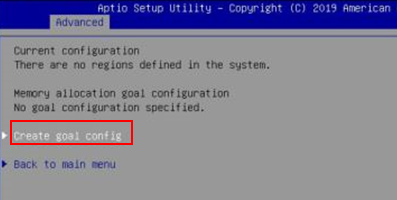
The App Direct type configures all the memory modules connected to a socket into one interleaved set, and creates one region for it. For example, if you have 1.5 Tb of persistent memory in memory mode and 256 Gb DDR4, the OS/Hypervisor would still onlyįor completely persistent memory or mixed mode, you can configure the persistent memory type as App Direct or App Direct Non Interleaved. In memory mode, DDR4 memory is used as a cache layer to the persistent memory module, and, is therefore not visible to the Also, if the percentage is changed, the resultant memory obtained May not accurately correspond to the specified percentage. In mixed mode, the percentage may not linearly translate into the actual memory available. For example, when you configure 20% Memory Mode, 20 percent of the persistent memory module is used as memory and the remaining 80 percent is used as persistent memory. When you configure a persistent memory module as x % Memory Mode, x% is used as memory and the remaining is used as persistent memory. Conversely, when it is configured as 0% Memory Mode, it becomes App Direct Mode and can be used completely as persistent memory. When a persistent memory module is configured as 100% Memory Mode, it can be used completely as volatile memory. Memory module to be used in Memory Mode, App Direct Mode, or Mixed Mode. Host tools only for namespace configurations if required.Ī goal is used to configure how persistent memory modules connected to a CPU socket are used. When using the UCS-managed, you can perform configuration tasks using the Cisco UCS management interfaces or the host tools.Ĭisco recommends that you use Cisco UCS management interfaces for all security operations and region management, and use the In the host-managed mode, you can use the host tools to configure and manage persistent memory modules. In the UCS-managed mode, you can use Cisco UCS Manager or Cisco IMC to configure and manage persistent memory modules. You can manage persistent memory module configuration using UCS-managed mode (Cisco IMC or UCS Manager) or the host-managed mode.

Quad CPU for UCS C480 M5 and B480 M5 serversįor UCS M5 and M6 B-Series and C-Series servers, the Near Memory (NM): Far Memory ratio (FM) ratio (DRAM + PMEM) is supportedīetween 1:4 and 1:16 in 100% memory mode.Įxample, 8 + 4 DRAM (16G) in 8 slots + PMEM (128G) in 4 slots =128G The population guidelines can be divided into the following, based on the number of CPU sockets:ĭual CPU for UCS C220 M6, UCS C240 M6, and UCS B200 M6 serversĭual CPU for UCS C220 M5, C240 M5, and B200 M5 servers
Install windows on optane dc persistent memory install#
Rules before you install or replace persistent memory modules. To ensure the best server performance, it is important that you are familiar with memory performance guidelines and population


Persistent Memory Module Population Guidelines Persistent memory modules provide faster access to data and retain data across power cycles, based on the mode. Persistent memory modules are non-volatile memory modules that bring together the low latency of memory and the persistence This release provides the ability to configure Intel ® Optane ™ DC persistent memory modules through Cisco IMC and Cisco UCS Manager. Intel ® Optane ™ DC persistent memory modules can be used only with the Second Generation Intel ® Xeon ® Scalable processors. Starting with Cisco UCS Manager Release 4.2, the support for the Intel ® Optane ™ Data Center persistent memory modules on the UCS M6 servers that are based on the Second Generation Intel ® Xeon ® Scalable are also provided.


 0 kommentar(er)
0 kommentar(er)
